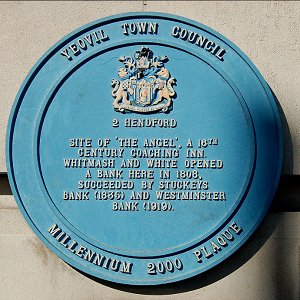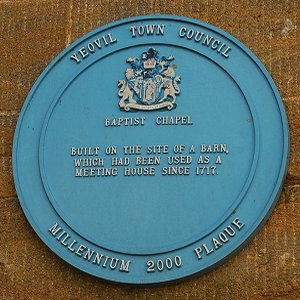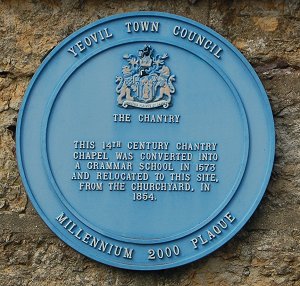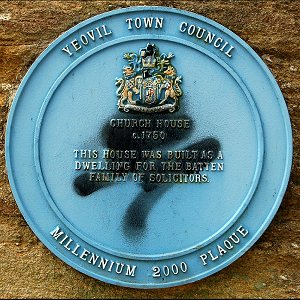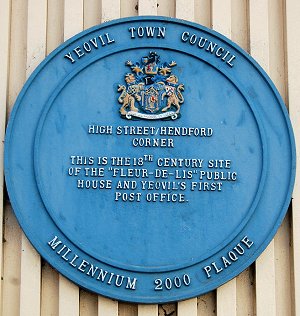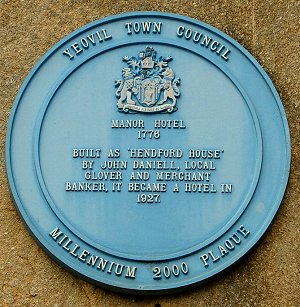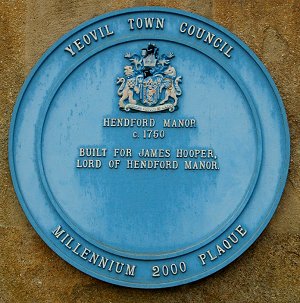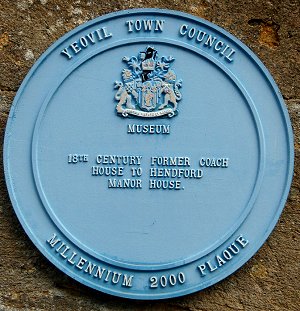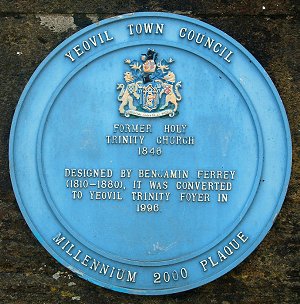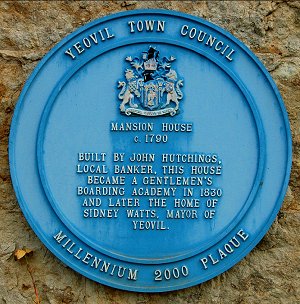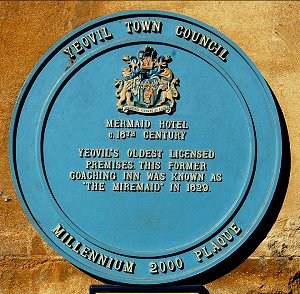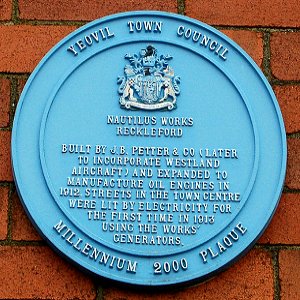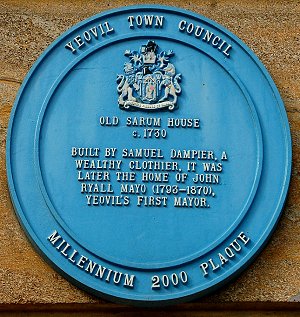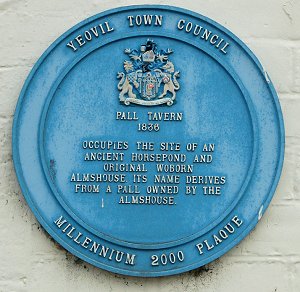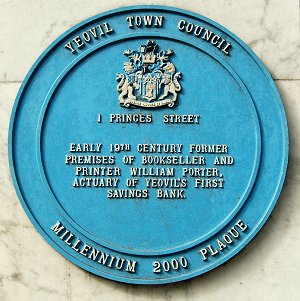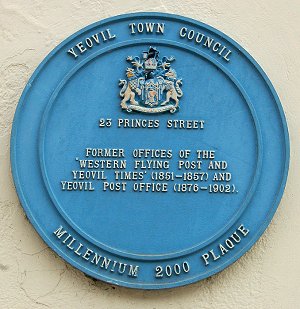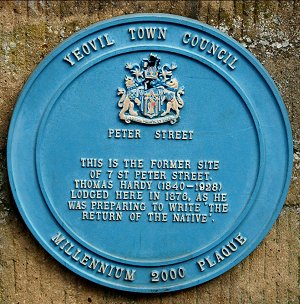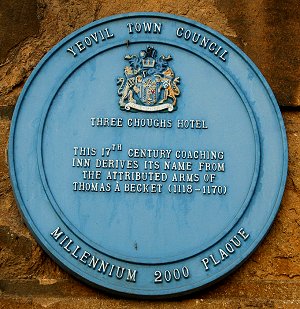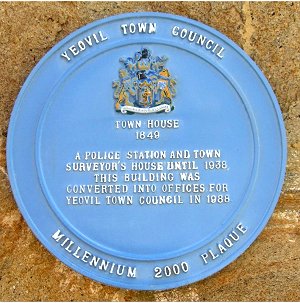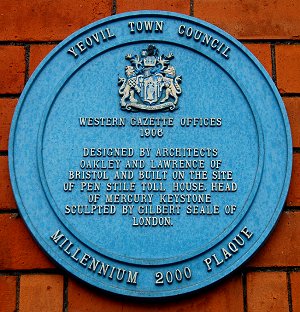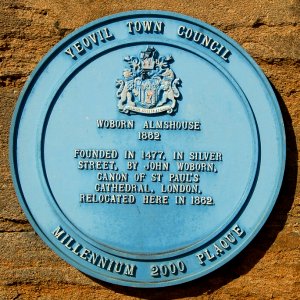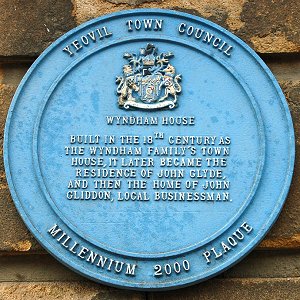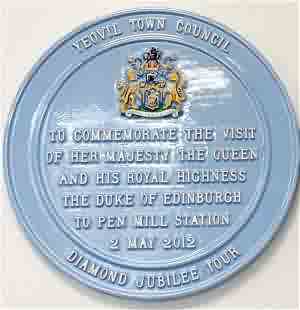Yeovil's blue plaques
Yeovil's Blue Plaques
Erected to celebrate the Millennium
To celebrate the Millennium, Yeovil Town Council erected twenty five blue plaques on important buildings or sites around the town (although there really should be twenty six as explained at the bottom of the page).
Tracking them down is a really pleasant way of spending an afternoon and it'll teach the children a lot about Yeovil's history - why not print this page out and take it with you as a checklist?
|
|
The Angel Inn once belonged to the Chantry of the Blessed Virgin Mary Without the Church, hence its name and sign. It stood on the corner of Hendford and Porter's Lane (now Westminster Street) facing High Street and the Borough - the site is now occupied by a bank building.
|
|
|
|
The record of Yeovil Baptists was on 12 February 1656. Their meetings in the town, of necessity in secret at first, were in South Street, from 1668 in a barn built by John Cary. The barn was converted to a Meeting House some time prior to 1717. Meetings continued to be held in the barn. In 1810 a chapel was built on or near the site of the barn, but because of the growing congregation, it was replaced by a larger building in 1828. |
|
|
|
The Chantry, probably early 14th century and most likely associated with an earlier church, was known as the 'Chantry Chapel of St Mary the Virgin without the Church' and was next to the tower of St John's church. The Chantry was demolished in order to increase the churchyard space for burials and was rebuilt in 1855 in its present position opposite the west door of St John's |
|
|
|
Church House, built for the Batten family and facing St John’s church, dates to about 1770 and is the finest remaining town house in Yeovil. It is built of stone with a red brick front and Ham stone dressings, cornice and parapet. The central doorway has a pediment and semi-circular entrance steps. There is an adjoining orangery with stone arcading. I must get another photo as the plaque has now been cleaned of the graffiti left by a mindless twat. |
|
|
|
The Fleur-de-Lys was a two-storied and cellared brick building at the location now occupied by part of Beale's in High Street, the Fleur-de-Lys had been a public house at least since the mid-18th century or probably much earlier still. It was also known as the Plume of Feathers. The shell of the building remains next door to Argos albeit completely remodelled and another storey was added. Yeovil's first Post Office was actually next door to the the Fleur-de-Lys and was replaced by Lindsay Denner's shop in 1836. |
|
|
|
Hendford House (now the Manor Hotel - It didn't become a licensed hotel until 1927) in Hendford, with its fine Georgian five-bay Ham stone elevation and recessed five-bay stable block, was built in 1776 and was originally the private house of local glover John Daniell the elder. The Daniell family came from East Coker and John later became a merchant banker setting up what became eventually known as Yeovil Old Bank. |
|
|
|
Hendford Manor, in Hendford, was originally built about 1740 for Rev. James Hooper, a Yeovil solicitor. Hendford Manor was one of the properties attacked and damaged by the mob of hundreds of protesters in the Yeovil Reform Riot of Friday, 21 October 1831. It was sold in 1840 to attorney Edwin Newman and his growing family of eleven children necessitated later extensions to the house; a plain north wing, together with a large dining room on the south side. The ornate porch was added around 1900. |
|
|
|
The eighteenth century Hendford Manor Coach House later housed Yeovil Museum. Now, sadly, Yeovil has no museum and all the artifacts are kept stored at Artillery Road. OK access to the artifacts is available by appointment, but it's hardly convenient and really does the town no favours. |
|
|
|
Holy Trinity church, now Yeovil Foyer, was erected in Peter Street and was built partly by grants and partly by voluntary subscriptions. The church was designed by diocesan architect Benjamin Ferrey and the foundation stone was laid on 24 June 1843. |
|
|
|
The Mansion House in Princes Street is a town house built in the late eighteenth century by banker John Hutchings. Watt's map of 1806 shows the property as belonging to John Hutchings Esq. with its rear gardens adjoining the Sheep Fair. At this time North Lane was known as Sheep Lane. |
|
|
|
The Mermaid is the oldest surviving licensed premises in Yeovil, despite an overabundance of competition, with the earliest mention in the records being 1517. It was recorded in 1629 as the Miremaide although many people tend to read too much into this spelling form while forgetting that before the 1870s there was no standardised system of spelling in the English language - even Shakespeare spelt his own name four different ways! Apart from two rooms at front it was completely rebuilt in 1769. |
|
|
|
Around 1881 James Bazeley Petter founded the Nautilus Stove Co, making grates and kitchen ranges. Initially these were made at the Nautilus Grate Works in Hendford but later moved to Vicarage Street. A factory (designed by James Petter's son, John, of the firm Petter & Warren) was built on the site of James's garden in Reckleford. This was named the Nautilus Works in commemoration of his Nautilus grate invention. |
|
|
|
The
Pen Style
Gate, literally
a gate across
the road, appeared in the
1841 census as
being controlled
by George
London, a
wagoner, who
lived in a
cottage there
with his wife
and four
children.
Later, a toll
house known as
the Newton Road
or Penstile
Turnpike House,
or Pen Stile
Toll House,
was constructed
for the gate
keeper in the
late 1840s.
In the
latter
part of
the 19th
century
it was
re-built
in its
present
position
on the
corner
of
Newton
Road and
South
Western
Terrace.
It is
now
named
Newton
Lodge. |
|
|
|
Old Sarum House is a fine, large three-storey house built in local limestone with Ham stone dressings. It was built about 1730 by Samuel Dampier senior (d1744), a wealthy clothier. The house was one of the properties attacked and damaged by the mob of hundreds of protesters in the Yeovil Reform Riot of Friday, 21 October 1831. Today it is an outlet of the Prezzo Italian restaurant chain. |
|
|
|
The Pall Tavern in Silver Street (as well as the Three Choughs Hotel and the George Inn) was for centuries owned by the Woborn Almshouse and the rent of the building provided income for the Almshouse. The current building only dates from 1836 but the first record in which the Pall is mentioned as an inn, as opposed to its earlier life as a private dwelling, is in a lease dated 1769. It does not occupy the site of the almshouse - that was behind the Pall and the Horse Pond was alongside it. |
|
|
|
Penn Villa, is a large residence in extensive grounds and was built about 1840. William Hunt first used ether as a dental anaesthetic in this house at Christmas 1847, a year after its first European use by London surgeon James Robinson. Hunt's son, William Hunt junior, published the earliest English paper on the use of hypodermic injection of cocaine as a local anaesthetic in 1886. Their house is still a dental surgery more than a century and a half later. |
|
|
|
Between 1815 and about 1825 this was the home and medical practice of surgeon Markes Lambe. In 1827 William Porter, printer of Yeovil, was on the Jury List as a stationer in Hendford (as this part of Princes Street was then known) on the corner of what was known as Porter's Lane (later to be widened and to become Westminster Street in the 1930's). By 1839 Porter was in partnership with Henry Marsh Custard and Porter & Custard, printers, remained in the premises at least until 1853. |
|
|
|
The building in Princes Street, on the corner with Church Street, was the former offices of the 'Western Flying Post and Yeovil Times' between 1861 and 1867. It became Yeovil's General Post Office after it transferred from Silver Street in 1876. In 1901 Henry Cobb was listed as being in charge of the 'Stamp Office'. It ceased to be a Post Office in 1902 when the new purpose-built Post Office opened in Middle Street (now the WH Smith building). |
|
|
|
In the late 1820's or early 1830's draper Peter Daniell planned and built an extension to Grope Lane (today's Wine Street) which became Union Street, then he built Bond Street and finally Peter Street, which he named after himself (although the plaque would seem to have made him a saint, it was only known by this name for a couple of months when newly built). Thomas Hardy stayed for a few months at 7 Peter Street in 1876 as he was preparing to write 'The Return of the Native'. |
|
|
|
It is not clear when the Three Choughs first opened. There is a date stone from 1724 on the South Street elevation but this is on a three-storey extension clearly added after the main building fronting Hendford was built. The records, however, clearly indicate that the Three Choughs was operating by 1664. The building, as well as other licensed premises (the Pall Tavern and the George Inn), was at one time owned by the Woborn Almshouse and the rent of the building provided income for the Almshouse. |
|
|
|
Yeovil's Watch House, the early equivalent of a Police Station, was originally in the Tolle Hall in the Borough but by the 1830s had literally been falling down for years. In 1849 the Town Commissioners built the building, now in Union Street, known as the Town House to provide a Police Station and a residence for a Superintendent, who was also the Town Surveyor and Rate Collector. The Town House remained a Police Station until 1938. In 1984 the Town House was acquired by Yeovil Town Council as their offices. |
|
|
|
The offices of the Western Gazette were officially opened in 1906 to replace earlier offices on the opposite corner of Newton Road. The building was designed by Bristol architects Oakley & Lawrence and built in the Renaissance style, the frontage is 45 feet high and the facade along Sherborne Road and Newton Road stretches a total of 141 feet. The construction company was Bird & Pippard, builders and undertakers of Middle Street. |
|
|
|
The Woborn Almshouse or hospital was founded in Yeovil under letters patent granted by King Edward IV, bearing the date 9th November 1476, in Silver Street. It was set up by John Woborn and Richard Huett, chaplains and benefactors, for the salvation of the soul of William Woborn, who was actually the minor canon of St Paul's Cathedral, London. The medieval almshouse had become so ruinous by the 1850’s that the new Woborn Almshouse was built in 1860 at its present site at the junction of South Street and Bond Street. |
|
|
|
Wyndham House, in Princes Street, was actually built around 1820 as the Wyndham family's town house. It later became the residence of John Glyde and then the home of local businessman John Gliddon. Originally a town house it is now shops with offices over and unusually, set in the pavement in front of the building, is a brass strip indicating the former boundary of the property when it was a private residence. |
|
|
|
This plaque was erected in the ticket office of Pen Mill station to mark the occasion of the Queen's visit to Yeovil on 2 May 2012. |
|
. . . . and finally
|
|
Please don't go looking for this one just yet as it's not there. Yeovil Town Council please note - this is the design for the plaque that should be mounted on the old Duke of Clarence pub in Stars Lane. Yes, I know I only lived there for two years but Mr T Hardy only lived in Peter Street for a few months and he got a plaque. Thanks
in
advance
|
